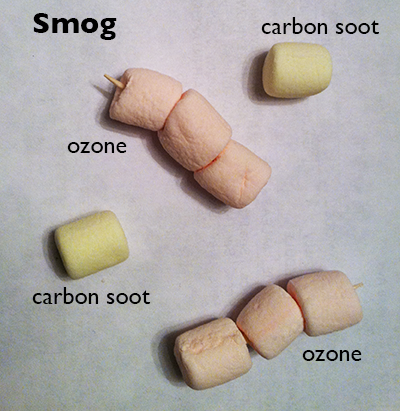Modeling Smog
In this activity, students create molecule models using marshmallows to understand and explain how smog forms.
Learning Objectives
- Explain how pollutants react with the air in sunlight to create new pollutants and soot to form smog.
Materials
- Multi-colored mini-marshmallows (representing atoms)
- Pink = Oxygen
- Green = Nitrogen
- Yellow = Carbon
- Toothpicks cut in half (used to hold atoms together to form molecule models)
- A toy car or picture of a car for each group of three students
- A toy Sun or picture of the Sun for each group of three students
- Optional: cameras, paper, markers (depending on how you'd like students to explain what they've learned)
Directions
Introduction
- Ask students, what is the first thing you think of when you hear the word smog?
- Discuss with a friend: Tell a story about a time when you encountered smoke or smog that made breathing difficult.
- Explain to students that in this activity they will model how smog is formed from auto exhaust using mini-marshmallows and toothpicks to represent molecules of gas in the air.

Step 1: Make some molecule models.
- Divide students into groups of three.
- Have one member of each group make enough nitrogen dioxide molecule models for each person in the group by using half of a toothpick to connect pink-green-pink marshmallows (in that order).
- Have a second member of each group make enough oxygen molecule models for each person in the group by using half of a toothpick to connect two pink marshmallows.
- Have the third member of each group gather a couple of carbon atoms (yellow marshmallows) for each person in the group.

Step 2 Model process of making smog!
Provide student groups with the following directions:
- Place the (toy or picture) car on your desk and place the nitrogen dioxide molecule models next to your car.
- Tell each member of your group that nitrogen dioxide represents some of the fumes given off by car exhaust.
- Place the Sun (toy or picture) on your desk next to the nitrogen dioxide model.
- In the presence of sunlight, take one of the pink oxygen marshmallows (atoms) off of nitrogen dioxide so you now have pink-green and pink.
- Explain to your team what happens to nitrogen dioxide in the presence of sunlight.
- Place some oxygen molecule models (pink-pink marshmallows) next to the NO (nitric oxide) and O (oxygen) models.
- Attach the single O (pink marshmallows) with the double pink-pink marshmallows making a pink-pink pink model. This is called ozone. Ground-level ozone is harmful to our health.
- Place some of the C (single yellow marshmallows) representing soot next to the ozone. Now you have a model of two of the main components of smog.
Students explain what they learned:
- Have students use the marshmallow models and create a cartoon that describes how the ground-level ozone and soot in smog form using their own words and drawings or photographs.
- Have students use marshmallow molecule models to explain how ozone forms at ground level during sunny days to someone who hasn’t completed this lesson.
- Have students write the answers to the following questions:
- What are three things you have learned from this lesson about smog?
- What are things you do not understand about smog?
- What is one question that you would like to ask an expert about smog?
Background
Ozone molecules (O3) have three oxygen atoms. While these molecules play an important role in the stratosphere, shielding Earth from harmful radiation, they are one of the primary components of smog when they are near the ground. As an air pollutant at ground level, ozone forms from other pollutants that are released from vehicle emissions, factories, and other sources. In the presence of sunlight, other pollutants are broken apart and ozone is formed as the free oxygen atoms attach to oxygen molecules. One of the main ways this happens is when nitrogen dioxide, an air pollutant, is broken apart into nitric oxide (NO) and oxygen (O) in the presence of sunlight. The single oxygen atom bonds to oxygen molecules (O2) to create ozone (O3). This is the process that students model in this activity.
Soot is a type of particulate matter and comes from many sources including the burning of fossil fuels and wood. Soot is another component of smog. In this activity, students add soot to their models as well. Other components of smog include nitrogen oxides, Volatile Organic Compounds (VOCs), and PAN (peroxyacetyl nitrate). Nitrogen oxides mostly come from the engines of cars and trucks. VOCs are given off by paint, gasoline, and pesticides. PAN is a type of pollution that is made by chemical reactions between other kinds of pollution.
When air is polluted, people breathe in ozone, particles like soot, and harmful gases that can hurt their lungs, heart, and overall health. Air pollution can cause coughing, burning eyes, and breathing problems. Fortunately, people usually start to feel better as soon as air quality improves, but not always. The elderly, the young, and those with cardiopulmonary disease, such as asthma or severe bronchitis, are the most vulnerable to air pollution exposure. Children are at greater risk because their lungs are still growing. Also, they play outside and are active. As a result, pound for pound they breathe more outdoor air pollution than most adults.
Although people have no choice but to breathe the air around them, they do have choices that can help them stay healthy. They can choose to stay indoors or be less active on poor air quality days. They can avoid high-traffic and highly industrialized areas whenever possible. They can also choose to support collective efforts and take individual steps that reduce air pollution. Such actions are a positive response to a problem that can literally steal one’s breath away.